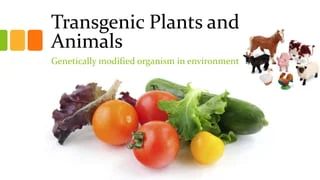
ABSTRACT:
In this article, we will discuss about the methods of transgenation in plants and animals. It is also called genetic engineering. Transgenation is the process in which a foreign DNA inserted in an organism. The animals and plants in which foreign gene inserted are called transgenic. Several useful products obtain from these genetic engineered plants and animals. For example: growth hormones, milk and other products. We will discuss the several several methods of genetic engineering with references.
INTRODUCTION:
Transgenation, also known as genetic engineering or genetic modification. It is a powerful tool that allows scientists to introduce specific genes into the DNA of organisms. This technique has revolutionized the fields of agriculture, medicine, and biotechnology by enabling the production of genetically modified animals and plants with desired traits. This article aims to explore the various methods used for transgenation in animals and plants, highlighting their advantages and limitations.
METHODS OF TRANSGENATION IN ANIMALS:
1. PRONUCLEAR MICROINJECTION:
Pronuclear microinjection is one of the earliest and most widely used methods for transgenation in animals. In this technique, a foreign DNA construct, containing the desired gene, injected into the pronucleus of a fertilized egg. The injected embryos then implanted into a surrogate mother for development. This method successfully used to generate transgenic mice, rats, and other small animals.

2. RETROVIRAL TRANSDUCTION:

3. SOMATIC CELL NUCLEAR TRANSFER:
Somatic cell nuclear transfer, also known as cloning, involves the transfer of the nucleus of a somatic cell into an enucleated egg cell. The resulting embryo carries the genetic material of the donor cell and genetically modified before implantation. SCNT has used to generate transgenic animals, including sheep, cows, and pigs, with specific genetic modifications.

METHODS OF TRANSGENATION IN PLANTS:
1. AGROBACTERIUM-MEDIATED TRANSFORMATION:
Agrobacterium-mediated transformation is a widely used method for transgenation in plants. Agrobacterium tumefaciens, a soil bacterium, naturally transfers a portion of its DNA, known as the T-DNA, into the plant genome. Scientists can modify the T-DNA to carry the desired gene and then use Agrobacterium to infect plant cells. The T-DNA integrates into the plant genome, resulting in the expression of the transgene. This method has been successfully used to generate transgenic crops, such as soybeans, corn, and cotton.

2. BIOLISTIC PARTICLE DELIVERY:
Biolistic particle delivery, also known as gene gun transformation. It involves the use of microscopic gold or tungsten particles coated with the desired gene. These particles are shot into plant cells using a high-pressure helium gun. The particles penetrate the cell wall and deliver the foreign DNA into the nucleus, where it integrates into the plant genome. This method has been used to generate transgenic plants, including wheat, rice, and tobacco.

3. CRISPR-CAS9 GENOME EDITING:
CRISPR-Cas9 is a revolutionary genome editing tool that allows scientists to precisely modify specific genes in plants. This technique involves the use of a guide RNA (gRNA) that directs the Cas9 enzyme to the target gene. The Cas9 enzyme then cuts the DNA at the desired location, allowing for the insertion, deletion, or modification of specific gene sequences. CRISPR-Cas9 has been used to create transgenic plants with improved traits, such as disease resistance and increased yield.

CONCLUSION:
Transgenation methods have greatly advanced our ability to modify the genetic makeup of animals and plants. These techniques have enabled the production of genetically modified organisms with desired traits, leading to significant advancements in agriculture, medicine, and biotechnology. As technology continues to evolve, it is likely that new and more efficient methods of transgenation will emerge, further expanding our capabilities in genetic engineering.
REFERENCES:
Gordon JW, Ruddle FH. Integration and stable germ line transmission of genes injected into mouse pronuclei. Science. 1981;214(4526):1244-1246. https://www.science.org/doi/10.1126/science.6272397
Houdebine LM. Production of pharmaceutical proteins by transgenic animals. Comp Immunol Microbiol Infect Dis. 2009;32(2):107-121. https://www.cabdirect.org/cabdirect/abstract/20093086981
Vajta G, Gjerris M. Science and technology of farm animal cloning: state of the art. Anim Reprod Sci. 2006;92(3-4):211-230. https://www.sciencedirect.com/science/article/abs/pii/S0378432005003660
Gelvin SB. Agrobacterium-mediated plant transformation: the biology behind the “gene-jockeying” tool. Microbiol Mol Biol Rev. 2003;67(1):16-37. https://journals.asm.org/doi/full/10.1128/mmbr.67.1.16-37.2003
Sanford JC, Klein TM, Wolf ED, Allen N. Delivery of substances into cells and tissues using a particle bombardment process. Particulate Science and Technology. 1987;5(1):27-37. https://www.semanticscholar.org/paper/DELIVERY-OF-SUBSTANCES-INTO-CELLS-AND-TISSUES-USING-Sanford-Klein/05453a2fd3900d19a09c526c6834af689d917675
Li JF, Norville JE, Aach J, et al. Multiplex and homologous recombination-mediated genome editing in Arabidopsis and Nicotiana benthamiana using guide RNA and Cas9. Nat Biotechnol. 2013;31(8):688-691.
Puchta H, Fauser F. Synthetic nucleases for genome engineering in plants: prospects for a bright future. Plant J. 2014;78(5):727-741.

